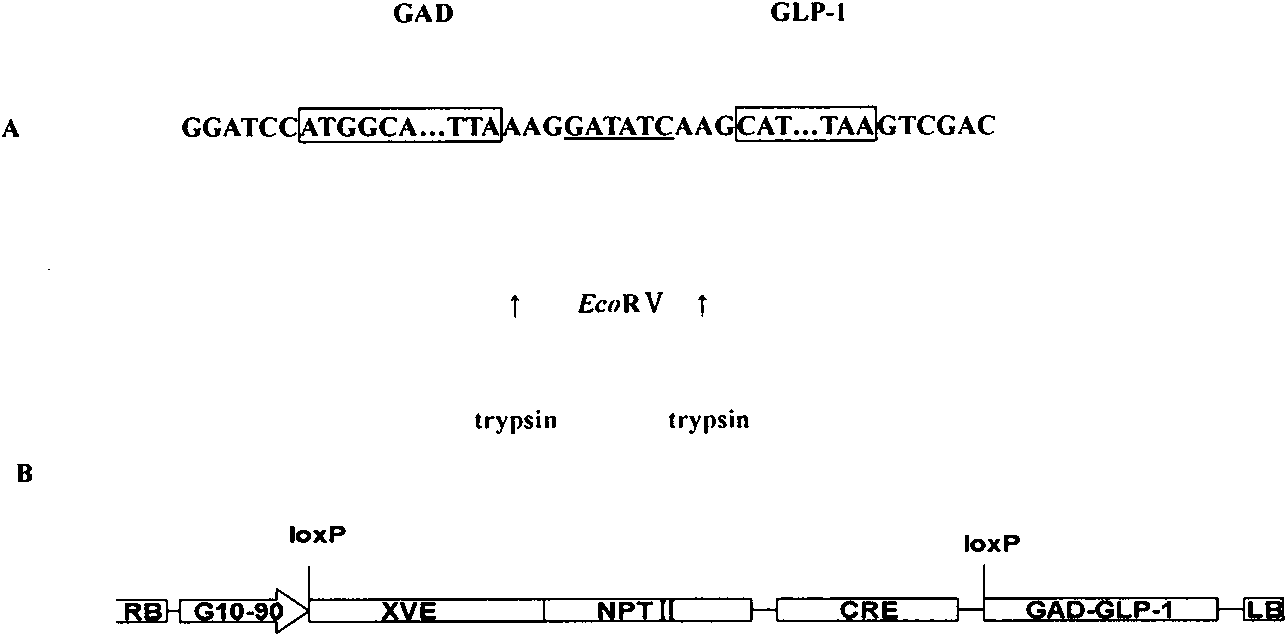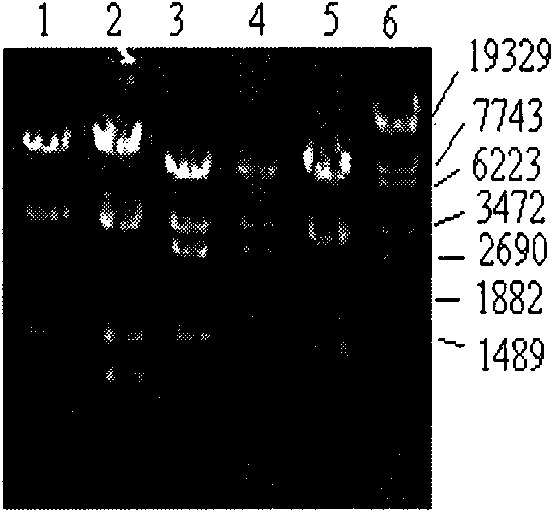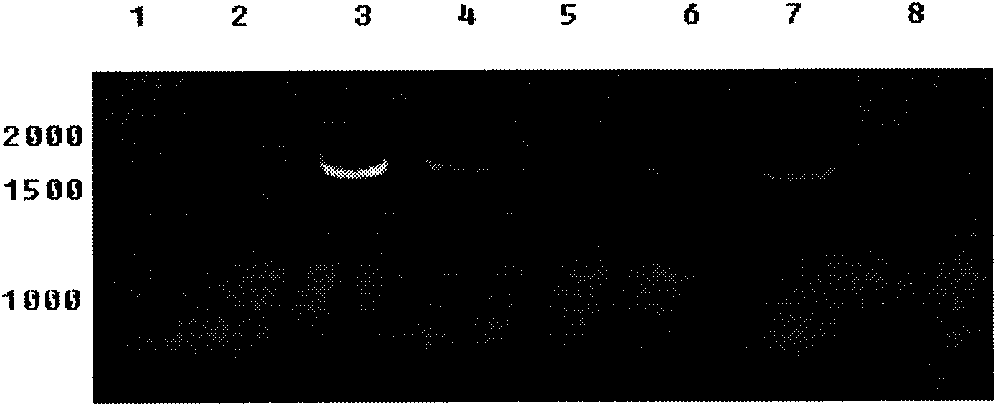Fusion gene GAD-GLP-1 and culture method of diabetes diet therapy type cucumber
A GAD-GLP-1, -1GLP-1 technology, applied in the field of plant genetic engineering, can solve the problem of undiscovered diabetes diet type cucumber, etc., achieve the effect of lowering blood sugar level and improving symptoms of diabetes
- Summary
- Abstract
- Description
- Claims
- Application Information
AI Technical Summary
Problems solved by technology
Method used
Image
Examples
Embodiment 1
[0044] Construction of a fusion gene GAD-GLP-1. Including the following steps:
[0045] (1) Cloning the GAD gene into a cloning vector to construct pMD-GAD. The PCR primers used in the experiment were designed according to the sequence of the GAD gene:
[0046] P1: 5′- GGATCC ATGGCATCTCCGGGCTCTG-3′,
[0047] P2: 5′- GATATC CTTTAAATCTTGTCCAAG-3′,
[0048] BamH I was introduced upstream of p1, and EcoRV site was introduced downstream of p2, both of which are underlined.
[0049] (2) Cloning the GLP-1 gene into a cloning vector to construct pMD-GLP-1. The PCR primers used in the experiment were designed according to the sequence of the GLP-1 gene:
[0050] P3: 5′- GATATC AAGCATTCTGAGGGAAC-3′,
[0051] P4: 5′- GTC GAC TTAACGGCCATCTACGAC-3′
[0052] An EcoRV site was added to the 5' end of P3, and a Sal I site was added to the 3' end of p4. Both are underlined.
[0053] (3) The cloning vector pMD-GAD was digested with BamHI and EcoRV, and the GAD fragment was obtai...
Embodiment 2
[0055] Construction of a Ti expression vector containing GAD-GLP-1 fusion gene
[0056] The cloning vector pMD-GAD-GLP-1 was digested with BamHI and SalI, and the GAD-GLP-1 gene with cohesive ends was obtained after digestion. Plasmid pX6 was completely digested with Spe I, and the cohesive ends of the vector and gene fragments were blunted. The purified GAD-GLP-1 gene fragment was ligated with the dephosphorylated linear vector pX6. Such as image 3 As shown, the exogenous gene has been connected into the vector pX6, and the transformant selected for forward connection is the expression vector used in the present invention, the Ti expression vector pX6-GAD-GLP-1 containing the GAD-GLP-1 fusion gene .
[0057] Transforming the above-mentioned Ti expression vector pX6-GAD-GLP-1 into Agrobacterium LBA4404 can obtain an engineering strain containing the GAD-GLP-1 fusion gene.
Embodiment 3
[0059] Breeding of transgenic cucumber expressing GAD-GLP-1 fusion protein
[0060] Take the cotyledon node of cucumber as the explant, infect with the suspension of the engineering strain described in claim 4 for 15 minutes, transfer to the co-culture medium for co-cultivation; then transfer the cotyledon node to the screening medium, and wait for the resistant bud to elongate When the buds grow to about 1.5-2cm, transfer them to the bud elongation medium; when the buds grow to 3-4cm, transfer to the rooting medium; when the roots grow to more than 4-6cm, and some lateral roots grow on the adventitious roots, grow Robust plants can be transplanted; the preparation of the culture medium is shown in Table 1.
[0061] Table 1 Medium used in this experiment
[0062]
[0063] according to Figure 6 As shown, kanamycin-resistant plants were obtained through cotyledonary node organogenesis pathway and 30 mg / L kanamycin resistance selection. After the obtained resistant plants ...
PUM
 Login to View More
Login to View More Abstract
Description
Claims
Application Information
 Login to View More
Login to View More - R&D
- Intellectual Property
- Life Sciences
- Materials
- Tech Scout
- Unparalleled Data Quality
- Higher Quality Content
- 60% Fewer Hallucinations
Browse by: Latest US Patents, China's latest patents, Technical Efficacy Thesaurus, Application Domain, Technology Topic, Popular Technical Reports.
© 2025 PatSnap. All rights reserved.Legal|Privacy policy|Modern Slavery Act Transparency Statement|Sitemap|About US| Contact US: help@patsnap.com



